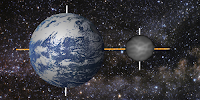- the Moon was a passing body captured by the Earth
- the Moon accreted in orbit at the same time as the Earth from the same material
- multiple moons collided to form the one large one we know
| Theia strikes a glancing blow (via Wikimedia Commons) |
New life for an old idea
While the giant impact hypothesis has yet to account for a few things, it seems, on the face of it, intuitively more reasonable than the supposition, once widely and seriously held, that the Moon formed by planetary fission... in other words, that the Earth simply spit it out. The usual mechanism for this is imagined to be centrifugal force from a still-soft and rapidly-spinning proto-Earth.
 |
| Myth Busted. via Wikipedia |
As unlikely and ridiculous as the Fission Theory may seem at first glance, this old model (surprisingly!) still has legs. One new variation is proposed by Japanese astronomer Okej Tenyoshou, professor emeritus of crypto-planetology and holder of the Kaiju chair at Toho University in Tokusatsu, Japan. Tenyoshou seeks to provide a model that better accounts for the similar chemistry of Moon rocks than does the Theia hypothesis.
Tenyoshou hypothesizes that the Earth wasn't always a water world. It was once a dry desert planet somewhat larger than the present Earth and similar to many of the "mega-Earths" that are increasingly found to be common by space-based observations made by the Kepler, Hubble, and Spitzer orbital telescopes. Tenyoshou calls his proto-Earth "Mogwai", and imagines a collision not with a Mars-like world, but with a Europa-like icy or watery planetoid he calls "Nuremashita". According to Tenyoshou, the proto-Earth being drenched by that impact set in motion a chain of events culminating in the Moon erupting from the mantle of planet Mogwai, leaving us with the present Earth-Moon system. As the geological processes involved are highly complex, Tenyoshou has created a fascinating visualization of the event. (click to view. My apologies. Due to technical limitations I'm unable to embed it here)
.



Is it April 1st again? Man, where did the year go?
ReplyDeleteWe'll cover that in an upcoming post. ;)
Delete